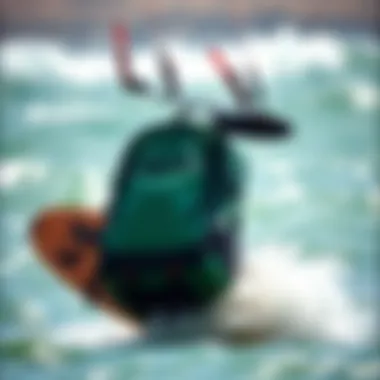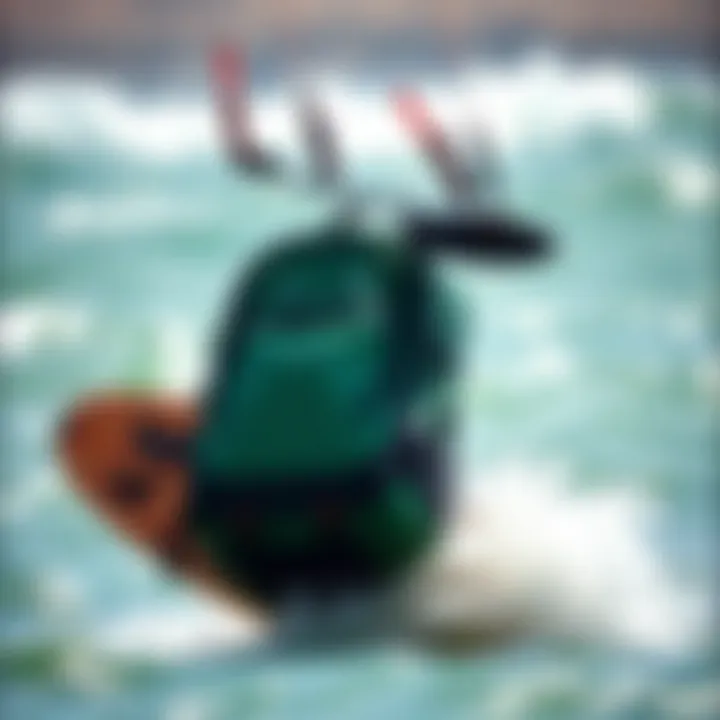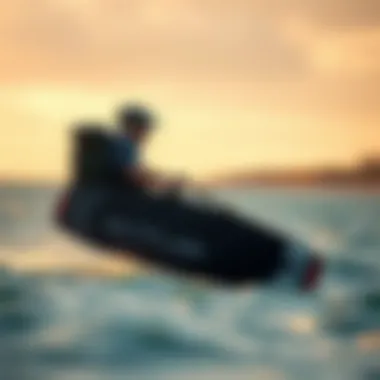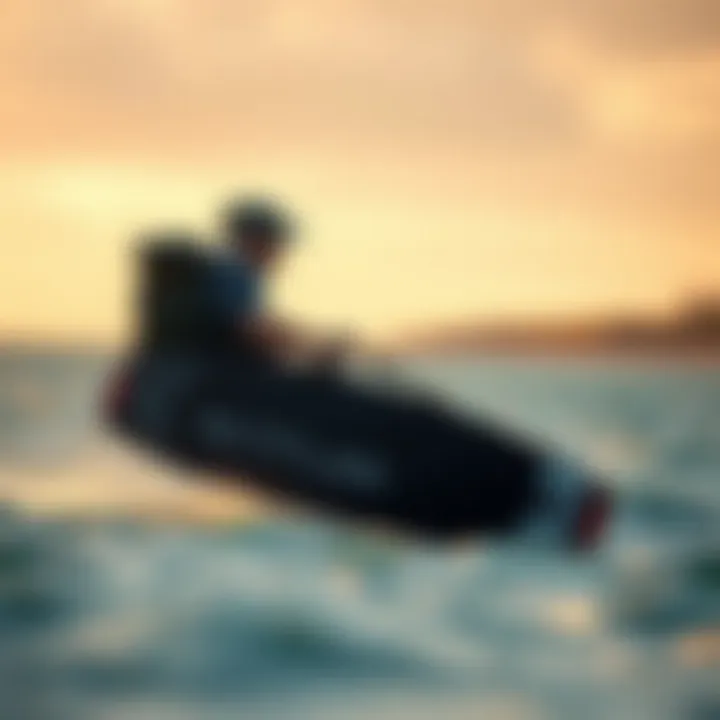Key Insights into Kite Board Bags for Enthusiasts


Intro
Kiteboarding, often seen as an exhilarating combination of surfing and flying, demands not only skill but also the right gear. One often overlooked aspect of this oceanic adventure is the kite board bag. A kite board bag serves more than just as a simple carrier; it is integral for safeguarding your equipment and streamlining your travels. Choosing the right kite board bag can have profound implications, be it for seasoned riders or newcomers looking to ease into this thrilling sport.
Gear and Equipment
In the kiteboarding world, how you take care of your gear is just as crucial as the gear itself. A quality kite board bag can preserve the lifespan of your kiteboard and help you avoid hassles during transport. It's vital for both packing your gear securely and providing protection during all your adventures.
Essential Kiteboarding Gear for Beginners
For those just starting, selecting the right gear can be daunting. The basic essentials would include:
- Kite: Choose a kite that matches your skill level and wind conditions. A beginner kite should offer stability and easier handling.
- Board: Typically, a larger board is better for beginners as it provides additional floatation.
- Harness: Look for a comfortable harness that fits well; it helps distribute the load while reducing strain on your body.
- Safety Gear: A helmet and impact vest can go a long way in ensuring your safety on the water.
- Kite Board Bag: Opt for a padded bag that caters specifically to the size of your board to avoid unnecessary wear.
Advanced Equipment for Experienced Riders
As riders evolve, so does their equipment. Advanced kiteboarders might focus on more categorized gear, such as:
- Performance Kites: These are typically designed for speed and maneuverability, often made from lighter materials.
- Specialty Boards: A surfboard or freestyle board tailored to specific riding styles can greatly enhance performance.
- Quick-Release System: Necessary for safety during jumps and tricks.
- Enhanced Kite Board Bag: Experienced riders may prefer bags that offer additional features like multiple compartments for all their gear, increased padding, and wheels for easier transport at airports or kite locations.
"The right bag not only prevents damage but also makes loading and unloading a breeze, especially when you're racing against daylight to catch the best winds."
Techniques and Tips
The right gear is just the beginning. Knowing how to manage your kite and board, as well as a few insider tips, can enhance your kiteboarding experience tremendously.
Basic Riding Techniques for Newbies
Starting with the basics is crucial. New riders should focus on the following techniques:
- Body Dragging: This helps in getting comfortable with the water and understanding how your kite steers.
- Getting Up on the Board: The transition from body dragging to riding requires practice; focus on smooth movements.
- Controlling Speed: Learning to manage your speed will help you maintain balance and avoid falls.
Expert Tricks to Elevate Your Skills
For those who have mastered the basics, pushing the boundaries is part of the fun. Consider these advanced techniques:
- Kite Loops: A thrilling way to add flair to your riding, but practice must be done in controlled conditions.
- Jumping: Perfecting your timing and edge control will unlock your ability to catch air and perform tricks.
- Downwind Progression: Skillful riders often focus on this technique as it allows you to travel longer distances while taking advantage of the wind.
Choosing the right kite board bags and mastering the techniques not only improves your performance but also enhances your enjoyment on the water. Remember, every expert was once a beginner, so stay curious and keep learning.
Preamble to Kite Board Bags
When it comes to kiteboarding, enthusiasts often think about the thrill of riding the waves and the perfect breeze. However, one essential aspect that should never be underestimated is the significance of kite board bags. These bags are more than just storage units; they play a critical role in safeguarding your gear, whether you’re transporting it across the globe or simply stowing it away after a session.
In this article, we will explore the fundamental elements of kite board bags, highlighting their key aspects, benefits, and considerations that every kiteboarder should keep in mind. Understanding kite board bags can directly impact not only the lifespan of your equipment but also your overall enjoyment of the sport.
Defining Kite Board Bags
Kite board bags serve a straightforward yet vital purpose: they protect your kiteboarding gear. In essence, these bags come in various designs and purposes, made specifically to house items like the board, kite, harness, and other essential components. The design and structure of a kite board bag can vary significantly, with options ranging from simple, lightweight pouches to more robust, hard-shell cases.
Kite board bags are typically made from durable materials such as polyester, nylon, or even some with protective padding, ensuring that your equipment remains safe from knocks and scrapes. Additionally, many bags feature compartments tailored for different items, allowing kiteboarders to organize their gear efficiently.
By understanding the different types of kite board bags, kiteboarders can select the right bag that aligns with their specific needs and preferences, ultimately enhancing their kiteboarding experience.


The Importance of Proper Gear Storage
Proper gear storage is crucial in kiteboarding. It’s the difference between a trip marred by damaged equipment and a journey filled with carefree rides. Kite boards and kites are often sensitive to environmental conditions, such as moisture, UV exposure, and temperature changes. Consequently, inadequate storage can lead to premature wear and tear.
Choosing the right kite board bag addresses these storage issues effectively. A bag designed to minimize exposure to moisture protects the gear from rust and decay, while a robust bag can shield against physical impacts during transit. Furthermore, special compartments help keep the equipment organized, reducing the risk of losing small components, which often happen when gear is just tossed around.
In summary, investing in a quality kite board bag is not just a matter of convenience; it’s a necessary step in ensuring that your kiteboarding gear remains in top condition for many impressive rides ahead. By safeguarding your gear, you can focus more on enjoying the thrill of kiteboarding, rather than worrying about the wear and tear of your equipment.
Types of Kite Board Bags
When it comes to kiteboarding, one thing's for sure – having the right bag can be as crucial as the gear itself. This section explores the different types of kite board bags and the roles they play for enthusiasts. The right choice ultimately hinges on personal needs, travel habits, and the kind of protection required for your gear. Understanding these categories not only helps with decision-making but also ensures your investment in kiteboarding equipment is well-protected and conveniently managed.
Travel Bags Versus Storage Bags
When you're on the move, travel bags are your best buddies. They’re designed with mobility in mind, often featuring wheels and robust handles, making it a breeze to maneuver through airports or rocky paths on your way to the beach. Travel bags generally prioritize durability and are built to withstand the rough and tumble of transport. They often include extra storage compartments for items like wetsuits, harnesses, and other necessary gear, offering both functionality and organization.
On the other hand, storage bags serve a different purpose. As the name suggests, they're designed primarily for keeping your gear safe when it’s not in use. They usually provide excellent padding and protection against dust and scratches. A dedicated storage bag may not have features like wheels or additional compartments, but it will keep your kite board safe and sound, ready for the next session once the conditions are just right.
Hard Cases Versus Soft Bags
Next up in our exploration are hard cases and soft bags – each with its unique benefits. Hard cases are like the Fort Knox of protection. Built with rigid materials, they offer superior defense against physical impacts, making them perfect if you’re worried about damage during air travel or transport. However, they can be heavier and bulkier than soft bags, which can be a downside if you’re traveling light.
Soft bags, in contrast, provide flexibility, and are often easier to stow away. They're lighter and can be packed into tighter spaces, which is a bonus for those road trips when every inch of your trunk space counts. That said, they may lack the solid protection that hard cases offer, so it’s a balancing act between weight and durability.
Single Board Bags Versus Multi-Board Bags
Lastly, there’s the choice between single board bags and multi-board bags. Single board bags are specifically tailored for one board, providing a snug fit and generally thicker padding. They’re ideal for those who have a favorite board they use extensively, as they minimize movement within the bag, minimizing the risk of scratches and damage.
Conversely, if you’re the kind of kiter who likes to switch things up or travel with multiple boards, multi-board bags are handy. They can accommodate two or more boards, which is great for versatility, especially if you're hitting up various spots where conditions might dictate different setups. While you gain the convenience of packing more in one bag, you might have to be mindful of the additional weight and bulk that comes with it. Choosing the right option often comes down to balancing your travel style with the protection requirements of your gear.
The right kite board bag can make all the difference in your kiteboarding experience, ensuring your gear is both protected and easily transportable.
In essence, knowing the types of kite board bags helps you navigate your choices better, ensuring your gear is tailored to your lifestyle, travel habits, and protection needs.
Materials and Construction
When it comes to kite board bags, the materials and construction are central to their effectiveness. Every kiteboarder, whether they are a weekend warrior or a seasoned pro, must consider how their bag is built. These aspects not only influence the bag's durability but also how well it can protect your gear from various adversities, such as weather changes, rough handling during transport, and the wear that comes from constant use. Ultimately, understanding materials and construction can be the difference between showing up with gear in pristine condition or facing damage before you even hit the waves.
Durability and Resistance to Elements
One of the first factors to consider is durability. The kite boarding experience often leads enthusiasts to beaches and remote locations where exposure to sand, salt, and water is commonplace. Materials like high-denier nylon or PVC tarpaulin are recommended for their resistance to tearing and abrasions. Many bags also feature reinforced stitching and wear patches, adding an extra layer of resilience, which keeps your expensive gear safe.
Additionally, having waterproof or at least water-resistant features drastically increases the longevity of the bag. A well-constructed kite board bag should hold up under rain and saltwater splashes, ensuring that the contents remain dry and intact.
"The right material can mean the difference between a fun trip and a costly repair."
Weight Considerations
Weight is another important consideration. While no one wants to lug around a heavy bag, it's crucial to balance weight with protection. Most seasoned kiteboarders prefer lightweight materials that don't skimp on sturdy construction. Go for bags that are made from rip-stop nylon or lightweight tarpaulin, as they effectively keep the weight down while still providing the needed protection.
However, a lighter weight shouldn’t mean a compromise in quality. This is where discerning the specifics of the chosen materials comes into play. Lightweight doesn’t have to mean flimsy—just pay attention to the construction quality and reinforcements used in high-stress areas. Sometimes it’s worth the weight for these features, especially if it means safely transporting multiple boards and kites.
Padding and Protection Features


Fadding and protection features are the jewels in the crown of kite board bags. Good padding not only cushions your boards during transport but also absorbs impact from drops or rough handling. Look for bags that offer at least 10 mm of padding; this is typically considered a good standard for safeguarding your gear.
Many bags incorporate additional features such as reinforced corners and side panels, which significantly bolster protection. Straps and padded dividers can also help to keep boards from clashing against each other, further enhancing the safety of your gear. Choosing a bag that prioritizes extra layers of protection can save you a fortune in repairs or replacements down the line.
In sum, when selecting kite board bags, paying attention to the materials and construction is key. The durability against the elements, weight considerations, and padding features all contribute to a bag’s ability to protect your gear and enhance your kiteboarding experience. Selecting the right bag ensures you are not just investing in a carrier but a safeguard for your valuable equipment.
Essential Features of Kite Board Bags
When considering the right kite board bag, prioritizing essential features can make a substantial difference in your kiteboarding experience. These features not only enhance the usability of the bag but also provide crucial protection for your gear. Understanding these key elements is vital for both newcomers and seasoned riders alike, as they impact convenience, security, and overall functionality.
Straps and Handles for Easy Transport
Moving from one location to another can often feel like a chore, particularly when hauling kiteboarding gear. That’s where the importance of straps and handles comes into play. Most kite board bags come equipped with padded shoulder straps that enable easy transport over longer distances, allowing you to carry your gear without breaking a sweat. Handles on the sides and top of a bag add versatility; whether you're loading your gear into a car or maneuvering through a crowded airport, having multiple carrying options can save you a lot of hassle. Some bags even feature a combination of both, with suitcase-style handles that make it easier to lift and move in tight spots.
"Whether it's a quick trip to the beach or a long-haul flight, the right straps and handles make all the difference to your travel experience."
Compartments and Storage Options
Another vital aspect of kite board bags is the various compartments and storage options available. A well-designed bag provides specific areas for your kite, board, and other necessary accessories, which helps in preventing damage and keeping your equipment organized.
Think about it: you don’t want your kite becoming tangled with your board or your harness. Many bags now come with designated pockets that cater to these needs, offering additional storage for items like your pump, spare lines, or even your wetsuit. It’s worth looking for bags that blend both functionality and thoughtful design, ensuring that everything has a place. When packing for trips, having easy access to your accessories can save you crucial time, especially when you're itching to hit the water.
Water and Sand Resistance
Last but certainly not least, consider the water and sand resistance of your kite board bag. Kiteboarding often means exposure to the elements, so your gear needs protection from both ocean spray and sandy beaches. Bags made with water-resistant materials can keep your equipment dry during transit and protect it from unexpected showers. Likewise, sand can be a tricky adversary, causing wear and tear if it gets into the zippers and seams of your bag. A well-constructed bag not only includes a waterproof exterior but may also have special seals or closures designed to keep sand and dirt out.
Maintaining your gear is essential for longevity, and investing in a kite board bag that prioritizes water and sand resistance is a smart move.
In essence, when selecting a kite board bag, consider the straps and handles for ease of transport, the compartments for ample storage, and the materials used for protection against the elements. Assessing these features can elevate your kiteboarding experience and provide peace of mind while you focus on the thrill of the ride.
Navigating Purchase Decisions
When it comes to kite board bags, choosing the right one can feel a bit like navigating through a labyrinth. Given the variety of options available, it’s crucial for kiteboarders to pinpoint what truly aligns with their needs. Making an informed decision involves focusing on personal usage, features, and budget constraints. In this section, we aim to unravel the complexities that guide your purchasing journey.
Assessing Personal Needs and Usage
Each kiteboarder has unique preferences and requirements, which makes understanding personal needs a cornerstone of the selection process. Think about the type of kiteboarding you engage in: are you more into freestyle, wave riding, or perhaps you dabble in a bit of everything? Your choice of bag will differ based on these considerations.
- Travel frequency: Are you a weekend warrior who hits the road occasionally or a globetrotter seeking exotic spots to catch waves? Frequent travelers would benefit more from sturdy bags with extra padding, whereas casual users might opt for lightweight and simpler designs.
- Board size: Your board dimensions play a direct role in the size of the bag you’ll need. A single board bag is often suitable for those with just one kiteboard. In contrast, multisport kiteboarders may need a larger multi-board bag capable of accommodating everything from twin-tips to surfboards.
- Storage Requirements: Consider additional equipment like kites, harnesses, and personal gear. If you plan to carry a multitude of items, look for bags that feature multiple compartments or pockets.
By reflecting on your individual kiteboarding habits and specific storage needs, you can streamline your search for the perfect kiteboard bag.
Understanding Price Points
When you head out to buy a kite board bag, the price tag can set the mood for the entire shopping experience. Kite bags come in a wide range of prices, and understanding what you’re paying for can make a world of difference.
- Budget bags: Entry-level options might save you a few dollars, but often cut corners on materials and padding. While they may suffice for occasional use, they might not last through rigorous conditions.
- Mid-range options: These typically offer a balance of quality and cost. They often incorporate a reasonable amount of padding, resistant materials, and durable zippers, catering to hobbyists.
- High-end bags: At the upper end of the spectrum are the high-performance bags made of premium materials, often featuring heavy-duty zippers and extensive protection. If you regularly travel with your gear or utilize your board under harsh conditions, investing in a quality bag will pay dividends.
Before finalizing a purchase, it’s wise to compare similar bags across different brands, ensuring you understand the value offered at each price point. This careful consideration not only ensures you’re spending wisely but that you're also selecting a bag that fits like a glove.
"Choosing wisely is far better than regretting later. In the world of kiteboarding, the right bag can make all the difference in preserving your gear."
In summary, navigating the myriad of options available in kite board bags is no small feat. By assessing your personal use and understanding the financial implications of your choices, you can make a purchase that supports your kiteboarding pursuits, ensuring that your gear is as protected as it is portable.


Kite Board Bag Maintenance
Kite board bag maintenance is an often overlooked yet crucial aspect for any kiteboarding enthusiast. Just like any piece of gear, your kite board bag endures various stresses, whether it’s during travel, storage, or everyday handling. Neglecting maintenance can lead to damage or faster wear and tear, ultimately impacting performance and functionality. Taking the time to care for your bag can help prolong its life, ensuring it remains a reliable companion on your kiteboarding adventures.
Cleaning Tips and Guidelines
Keeping your kite board bag clean isn’t just about aesthetics; it plays a significant role in maintaining the integrity of the materials used in your bag. Sand and saltwater can deteriorate the bags' fabric over time, leading to premature wear. Here are some effective cleaning tips:
- Rinse After Use: Always rinse your bag with fresh water after use, especially if you’ve been on the beach. This helps remove salt and sand that can cause erosion in the fabric.
- Use Mild Detergents: When cleaning your bag, opt for gentle detergent and warm water. Avoid harsh chemicals as they can weaken the fabric and protectants.
- Air Dry: After washing, let your bag air dry in a shaded area. Direct sunlight can cause colors to fade and may degrade materials over time.
- Spot Cleaning: For stubborn stains, use a soft brush or cloth with a bit of soapy water to spot clean, then rinse it off with water afterward.
A little care can go a long way—keeping your kite board bag clean not only looks good but also keeps it performing at its best.
Long-Term Care and Storage
Storing your kite board bag correctly can significantly extend its life. Improper storage practices can lead to structural damage and the development of mildew if the bag is not correctly dried out. Here are some tips for long-term care and storage:
- Store in a Cool, Dry Place: Choose a storage area that is not exposed to extreme temperatures or humidity. This can help prevent the growth of mold and keep the bag materials stable.
- Empty It Out: Always remove any gear or accessories before storing the bag. Leaving items inside can lead to odors and damage over time.
- Avoid Heavy Weights on Top: When storing your bag, ensure it’s not squished or has heavy items placed on top, as this can deform the structure or wear on the zippers.
- Check Periodically: Make it a habit to look through your bag every so often, cleaning and checking for any signs of wear or damage. Early detection can save you from major repairs down the line.
With a little diligence in maintenance, your kite board bag can continue to serve you through countless adventures, ensuring your gear stays protected and ready whenever you are.
Travel Considerations with Kite Board Bags
Traveling with kite board bags can be a true adventure, combining the thrill of kiteboarding with the intricacies of logistics. Understanding how to navigate your travels with these bags plays a crucial role in ensuring that your equipment remains safe and your kiteboarding experience is seamless. Each travel scenario presents unique challenges, whether flying to a distant kiteboarding destination or driving a few hours to the local beach. It is essential to keep in mind both the requirements set by transportation companies and practical tips to make your journey as hassle-free as possible.
Airline Regulations and Fees
When it comes to air travel, kiteboarders must be acutely aware of each airline's policies that govern the transportation of sports equipment. Most airlines classify kiteboard bags as oversized luggage, which often incurs additional fees. Here are some key points to consider:
- Weight Limits: Many airlines set specific weight limits for checked baggage. If your kite board bag exceeds this weight, you may face hefty fees. It’s wise to weigh your bag before heading to the airport.
- Dimensions: Similar to weight, dimensions can lead to extra fees. Ensure your bag’s length, width, and height align with the airline's requirements. Some airlines allow kiteboard bags up to a certain size without imposing additional charges.
- Pre-Check Policies: It's advisable to check the airline's website for any pre-checks necessary for oversized baggage. This will save you time at the airport and ensure you're fully prepared.
- Insurance and Liability: Given that airline handling can be a tad rough, considering travel insurance for your gear can be prudent. Coverage may provide peace of mind in case of damage or loss.
Always verify airline policies directly before booking your flight. Rules could vary drastically, impacting your travel budget and plans.
Tips for Road Trips and Local Travel
For those opting for road trips or local travel, while you have more flexibility compared to flying, several considerations still come into play:
- Strap it Down: Ensure your kiteboard bag is secured in the vehicle. Use straps or tie-downs to prevent it from moving around, especially on bumpy roads. This protects the bag and its contents.
- Organize Your Gear: Arrange your items in an organized manner. Place heavier items at the bottom and keep smaller accessories easily accessible. This can save you time when you reach your destination.
- Keep it Dry: If your route entails unpredictable weather, consider using additional tarpaulin or rain covers to keep your kiteboarding gear dry and safe.
- Rest Stops: Plan for breaks during long drives. This gives you a chance to check on your gear and ensures that you, too, are rested for a day of kiteboarding.
- Local Regulations: Be mindful of local laws regarding carrying oversized items, especially when using public transport or parking facilities. Familiarize yourself with the area’s rules to avoid any hiccups.
In summary, whether flying or driving, maintaining a smooth travel experience with kite board bags involves understanding regulations and logistics while factoring in the safety of your gear. Taking these travel considerations into account will maximize your time enjoying the beautiful waves.
Epilogue
As we wrap up our exploration of kite board bags, it becomes clear just how crucial these bags are to the sport of kiteboarding. The significance of a well-chosen kite board bag goes beyond mere storage; it is about ensuring the longevity of your gear, safeguarding it from the elements, and facilitating easier transport for those adventures both near and far.
Recap of the Importance of Kite Board Bags
Kite board bags are indispensable for any kiteboarding enthusiast. They serve to protect expensive equipment from damage during storage and transit. A sturdy bag not only extends the life of your gear but also enhances the overall experience of transporting it, especially during air travel or road trips. Additionally, bags equipped with organizational features allow for efficient packing, enabling you to store not just your board, but also kites, harnesses, and other necessary accessories without hassle.
- Protection: Prevention of scratches and impact damage during transport.
- Convenience: Ease of transport with additional compartments for other gear.
- Organizational Features: Faster access to equipment when disembarking at a location.
Ultimately, the right kite board bag is a tailored solution that meets individual needs, which in turn contributes to a smoother kiteboarding experience.
Final Thoughts on Choosing the Right Bag
Choosing the perfect kite board bag requires a thoughtful approach. Each kiteboarder's needs will diverge based on their personal style, frequency of travel, and specific gear. While some may prioritize lightweight materials for easy transport, others might lean towards durability and protection over all else. It’s essential to consider factors such as padding, size, compartments, and even aesthetic preferences.
"The right bag can turn the daunting task of gear transport into a breeze, letting the attention focus on the ride, not the hassle."
In sum, whether you're looking for a soft bag for everyday use or a robust hard case for international trips, there’s a bag out there that perfectly aligns with your needs. Through careful consideration of what features matter most to you, you'll find a kite board bag that not only meets your requirements but enriches your kiteboarding adventures.
Incorporating thoughtful investment into the quality of gear storage can provide peace of mind, enabling kiteboarders to focus on what truly matters: the thrill of the ride and the experience of the elements.















